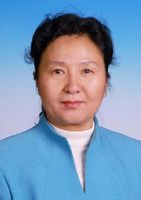Qu Yajun is a professor at Shaanxi Normal University, Xian, China, and director of both the Women’s Research Center and Women Culture Museum of the university. Despite the fact that the Japan-China relationship was in danger of being jeopardized by the Senkaku (Diaoyu) Islands dispute, with even cultural exchanges suspended in many cases, she visited Tokyo as originally scheduled to speak about women’s studies and her experiences in China.
Prof.Qu’s lectures were both impressive as well as timely, all the more because they were given in the midst of the difficult time between the two countries. What follows is a report on her presentation made at the meeting of the Women’s Studies Association of Japan, on Saturday, November 10, 2012, at Rissho University, entitled “Three Kinds of Women’s Discourses in Modern China.”
Based on what I (the writer of this report) understood from Prof.Qu’s speech, I will describe the major points of the two days of lectures in two consecutive reports, of which this is Part 1, and will also add my personal comments inspired by her lectures.
(1) “Half the Sky” Discourse
Back in the Cold War period, socialist countries were often depicted as dreams come true. China was also highly regarded at the time in terms of women’s status in society as evidenced by the quotation of Mao Zedong,“women hold up half the sky.”
According to Prof.Qu, these words of Mao suggested that women are as capable as men. As a result of the Chinese Revolution, the traditional idea of “men outside, women inside” was overthrown, replaced by the ideal of independence, liberation and equality of men and women. The major promoter of the “half the sky” discourse was the All China Women’s Federation (hereinafter ACWF), formed in March 1949, even before Chairman Mao’s declaration of the People’s Republic of China.
According to Prof.Qu, however, the widely accepted notion of women being equal to men could be misinterpreted as women acting like men. Since the “half the sky” is a mainstream discourse, it carries ideological dogmatism and authoritarianism with it. As it regards self-pride, self-confidence, self-independence and self-empowerment as its standards, the discourse tends to leave women unaware of their actually weak position in a still patriarchal society.
After the 1980s, Prof. Qu points out, the above-mentioned four “self”s were no longer so obviously praised in novels but the “half the sky” discourse was represented by brave women soldiers, excellent women judges and successful businesswomen instead.
(2) “Feminist” Discourse
In the same period, Prof. Qu reminded us, China started to be influenced by Western feminism. Especially after the fourth UN Conference on Women held in Beijing in 1995, awareness of feminism was enhanced and attention to the socially weak, including women, increased. There began a move to deconstruct masculine culture and to interpret sex and gender as a political discourse.
Compared to the “half the sky” discourse, this new “feminism” was characterized more as an attempt by women for women to emancipate themselves. Instead of being on the receiving end of social liberation, feminist women now began to fight their way into their specialized research areas from a gender-oriented perspective, eschewing mainstream ideology.
According to Prof. Qu, more than one hundred research institutes have been established in China, carrying the term “gender,” “feminism” or “women,” serving to raise the status of women’s studies in higher education. On the other hand, her concern is that they tend to be plagued by staff shortages, budget problems and a lack of facilities. Furthermore, Prof. Qu goes on to say, post-modern philosophy, which represents the core of feminist theory, is too difficult for ordinary people to understand. Therefore, in her view, feminist oriented studies, in their efforts to counter male-centrism, could cause anew a center-peripheral conflict between woman and woman.
Nonetheless, Prof.Qu observes that the “half the sky” and “feminist” discourses tend to merge with each other. The facilitating factors include deepened understanding between the chief staff of relevant departments of ACWF and women scholars through joint efforts in various activities. As reform and open policy accelerates, the boundary between women staff from the proletarian class and women scholars from intellectual families have also been removed.
(3) Emergence of “Modern Ladies” and Coexistence of the 3 Confronting DiscourseS?
Against the above-mentioned two kinds of women in modern China, quite a new category called “modern ladies” emerged. Prof. Qu introduced them as the kind of white collar woman one finds on the cover of fashion magazines or the beautiful women serving as TV newscasters.
They know that they cannot expect to enjoy any more protective measures as women in severe competition in a market economy. They disagree with the “half the sky” discourse as it is so old-fashioned and criticize the “feminist” discourse as it is too radical. Prof. Qu is critical of the “modern ladies” discourse because it has internalized men’s view of masculine culture, as women’s beauty, elegance, gentleness and weakness are being commercialized.
Prof. Qu does not see the boundary between the “modern ladies” and “feminist” discourses as clear and fixed. She maintains that those concepts like “personal” and “private” from Western feminism are also characteristic of the “modern ladies”. But the “modern ladies” discourse was generated and developed along with the market, which is the mainstream ideology in present-day China. So it contradicts with the “feminist” discourse which is characterized by its attention to the periphery. No matter how apparently the “modern ladies” try to come off as appearing advanced in the business world, they inevitably end up being objectified and alienated in men’s eyes.
There was a question raised by the audience as to how the “housewives” are positioned within those discourses, but unfortunately Prof. Qu did not have time to elaborate on this issue.
A few weeks later, I had a chance to meet a Chinese friend, a young woman working at a publishing company in Beijing. In response to my question, she presented her personal view, saying that those “modern ladies” seek to meet one of those “new rich” men who were also the product of the market economy, and become a housewife. Unlike activists or scholars, the ordinary women seem to be strongly affected by the “modern ladies” discourse.
At the end of this lecture, Prof. Qu summarized the relationship between the coexisting three discourses about women as follows:
All three are double-sided in their own way, complicating their relationship. The government authorized “half the sky” discourse certainly freed Chinese women of some burdens western women must have tackled. It could control the negative results of commercialism through its orthodoxy. And yet, its orthodoxy could become conservatism, resulting in conflict with the radical “feminism” discourse. The “feminism” discourse, which could be a powerful weapon to fight back against masculine ideology, might come to a dead end if it recklessly crashes with the “half the sky” discourse, ignoring cultural and social characteristics of Chinese society and practices. The “modern ladies” discourse is attractive because of its newness and trendiness, but might become retrogressive as the society itself advances.
~~To be continued in Part 2~~
 慰安婦
慰安婦 貧困・福祉
貧困・福祉 DV・性暴力・ハラスメント
DV・性暴力・ハラスメント 非婚・結婚・離婚
非婚・結婚・離婚 セクシュアリティ
セクシュアリティ くらし・生活
くらし・生活 身体・健康
身体・健康 リプロ・ヘルス
リプロ・ヘルス 脱原発
脱原発 女性政策
女性政策 憲法・平和
憲法・平和 高齢社会
高齢社会 子育て・教育
子育て・教育 性表現
性表現 LGBT
LGBT 最終講義
最終講義 博士論文
博士論文 研究助成・公募
研究助成・公募 アート情報
アート情報 女性運動・グループ
女性運動・グループ フェミニストカウンセリング
フェミニストカウンセリング 弁護士
弁護士 女性センター
女性センター セレクトニュース
セレクトニュース マスコミが騒がないニュース
マスコミが騒がないニュース 女の本屋
女の本屋 ブックトーク
ブックトーク シネマラウンジ
シネマラウンジ ミニコミ図書館
ミニコミ図書館 エッセイ
エッセイ WAN基金
WAN基金 お助け情報
お助け情報 WANマーケット
WANマーケット 女と政治をつなぐ
女と政治をつなぐ Worldwide WAN
Worldwide WAN わいわいWAN
わいわいWAN 女性学講座
女性学講座 上野研究室
上野研究室 原発ゼロの道
原発ゼロの道 動画
動画



![[広告]広告募集中](https://wan.or.jp/assets/front/img/side_ads-call.png)












